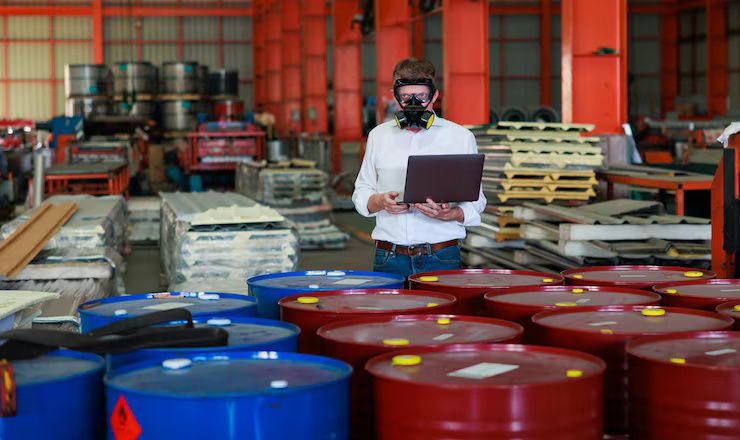Everything You Need to Know About Global Chemical Supply Chains
Global chemical supply chains form the backbone of industries that produce essential goods — from pharmaceuticals and plastics to fertilizers and electronics. These supply chains involve the production, storage, and transport of chemicals across multiple countries, linking manufacturers, distributors, and end-users in a tightly regulated ecosystem.
The chemical industry is one of the world’s largest industrial sectors, valued at over $5 trillion globally. It relies heavily on raw material availability, safe logistics, and trade coordination. The purpose of such supply chains is to ensure a continuous and efficient flow of materials used in industrial production, agriculture, healthcare, and energy.

However, because chemicals are often hazardous or regulated substances, managing their movement requires strict safety standards and compliance with international laws.
Importance – Why Chemical Supply Chains Matter Today
The significance of chemical supply chains extends far beyond manufacturing. They are vital for economic stability, public safety, and technological progress.
1. Economic impact
Chemical supply chains contribute to industrial output, export earnings, and employment in countries like the United States, China, Germany, and India. Many industries — including automotive, agriculture, and construction — depend on chemical products for growth.
2. Supply security
Disruptions in chemical logistics can cause widespread shortages of goods such as medicines, plastics, and fertilizers. Maintaining resilient supply networks ensures global stability in critical sectors.
3. Environmental and safety considerations
Proper chemical handling reduces environmental pollution, workplace accidents, and health hazards. Safe transportation and storage protect workers and communities.
4. Innovation and sustainability
New trends like green chemistry and circular economy practices are shaping how chemicals are produced and distributed, focusing on recycling, renewable materials, and low-carbon technologies.
In essence, the health of chemical supply chains directly affects industrial growth, environmental safety, and global trade balance.
Recent Updates – Key Developments and Trends (2024–2025)
Over the last year, several major changes have influenced the global chemical supply landscape:
1. Shift toward sustainable production (2024–2025)
Many global manufacturers, including BASF and Dow Chemical, are investing in renewable feedstocks and reducing carbon emissions in line with net-zero targets by 2050.
2. Supply diversification post-pandemic
After disruptions during the COVID-19 era, companies are moving away from single-region dependence (e.g., China) and diversifying production across Southeast Asia, Europe, and North America.
3. Digital transformation in logistics
In 2025, more chemical suppliers are adopting AI-driven tracking systems, IoT sensors, and blockchain-based traceability tools to improve visibility and prevent supply delays.
4. Energy cost volatility
Energy prices have remained unstable since mid-2024, especially in Europe, impacting production costs for energy-intensive chemical processes like ammonia and ethylene manufacturing.
5. Trade regulations and geopolitical shifts
Tensions in major trade routes (such as the Red Sea and Taiwan Strait) have pushed companies to optimize routes through Africa and South America, balancing risk and delivery timelines.
6. Circular economy integration
Recycling initiatives and sustainable packaging chemicals are gaining traction as part of corporate environmental goals and government incentives.
Laws or Policies – Regulatory Framework Governing Chemical Supply Chains
Because chemicals can be hazardous, most countries enforce strict policies to ensure environmental protection, worker safety, and fair trade. Global chemical supply chains are shaped by a combination of international agreements and national laws.
Key global frameworks:
-
REACH (Registration, Evaluation, Authorisation, and Restriction of Chemicals) – European Union regulation governing chemical safety and import/export compliance.
-
TSCA (Toxic Substances Control Act) – U.S. law controlling chemical production and distribution to protect human health.
-
GHS (Globally Harmonized System of Classification and Labelling of Chemicals) – Standardizes chemical hazard classification and labeling worldwide.
-
Basel Convention – Regulates transboundary movement of hazardous waste and chemicals.
-
OECD Guidelines for Chemical Safety – Provide international testing and reporting standards for chemical management.
Regional initiatives:
-
India’s Chemical (Management and Safety) Rules (2023) introduced local registration and import notification processes.
-
China’s MEE Order No. 12 requires companies to register new chemical substances with environmental authorities.
-
Middle East & Africa are implementing stricter import controls to align with EU GHS standards.
Compliance with these frameworks ensures smoother cross-border trade, reduced accidents, and enhanced sustainability throughout the supply chain.
Tools and Resources – Helpful Platforms for Managing Chemical Supply Chains
Companies engaged in chemical production, trade, or logistics rely on digital tools to ensure safety, efficiency, and compliance. Below are key platforms and resources widely used across the industry:
| Tool / Platform | Purpose | Type |
|---|---|---|
| SAP EHS Management | Tracks compliance, safety, and hazard communication | Software |
| Chemwatch | SDS (Safety Data Sheet) management and chemical inventory | Software |
| ICIS Supply Chain Analytics | Provides market insights, pricing, and logistics data | Platform |
| Intertek Assurance | Auditing and certification for global chemical standards | Service |
| TradeLens (IBM + Maersk) | Blockchain-based supply chain transparency | Platform |
| ChemLinked | Database for Asian chemical regulations and updates | Website |
| World Chemical Information Service (WCIS) | Global data on chemical production and trade | Database |
| Cefic (European Chemical Industry Council) | EU policy and sustainability resources | Organization |
| EcoVadis | Supply chain sustainability rating and monitoring | Platform |
| HazMat Online | Training and safety documentation for transport compliance | Online Training |
These resources help businesses reduce risk, enhance traceability, and meet international safety and reporting standards.
Table: Major Chemical Exporting Countries (2025)
| Country | Annual Export Value (USD billions) | Primary Export Chemicals |
|---|---|---|
| China | 410 | Plastics, fertilizers, pharmaceuticals |
| United States | 320 | Polymers, specialty chemicals, solvents |
| Germany | 290 | Industrial gases, coatings, fine chemicals |
| India | 180 | APIs (Active Pharmaceutical Ingredients), dyes, agrochemicals |
| Netherlands | 150 | Petrochemicals, polymers, lubricants |
(Source: UN Comtrade, 2025 estimates)
This data shows how chemical exports remain concentrated among a few major industrial economies, emphasizing the importance of global cooperation and logistics efficiency.
FAQs – Common Questions About Global Chemical Supply Chains
1. What are the main challenges in global chemical supply chains?
The biggest challenges include transportation delays, regulatory differences across countries, energy price volatility, and limited raw material availability.
2. How are digital technologies improving chemical logistics?
Technologies like IoT, blockchain, and AI are improving shipment tracking, predictive maintenance, and documentation accuracy, leading to faster and safer deliveries.
3. What is the role of sustainability in chemical supply chains?
Sustainability focuses on reducing emissions, recycling materials, and replacing hazardous substances with eco-friendly alternatives to protect people and the planet.
4. How do geopolitical tensions impact chemical trade?
Trade conflicts or shipping route blockages can increase costs, extend delivery times, and create shortages of critical industrial materials.
5. How do companies ensure compliance with international regulations?
Firms use specialized software, third-party audits, and in-house EHS (Environment, Health, and Safety) teams to ensure their operations meet global and local standards.
Final Thoughts
Global chemical supply chains are among the most complex logistical networks in the world. They connect industries, economies, and consumers across continents — supplying materials that shape everything from healthcare to construction.
As sustainability, technology, and regulatory compliance continue to evolve, businesses must stay informed and adaptable. The future of chemical supply chains lies in transparency, safety, and innovation — supported by data-driven decision-making and global cooperation.
Whether you are a chemical trader, manufacturer, or logistics manager, understanding the flow of global chemical supplies is key to ensuring both business success and environmental responsibility.





